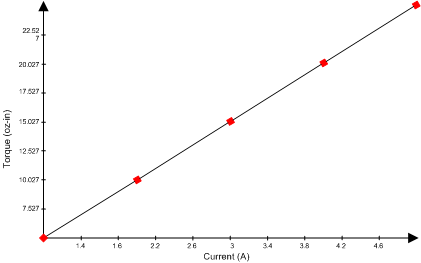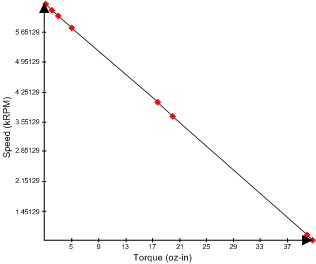SLVA654B June 2014 – March 2019 DRV8301 , DRV8301-Q1 , DRV8302 , DRV8303 , DRV8307 , DRV8308 , DRV8312 , DRV8323R , DRV8332
-
Hardware design considerations for an efficient vacuum cleaner using a BLDC motor
- Trademarks
- 1 Suction Principle
- 2 Brushless DC Motors (BLDC)
- 3 Microcontrollers
- 4 Gate Driver and MOSFETs
- 5 Isolation
- 6 Power Management (6 to 60-V DC Power Supply)
- 7 CAP and QEP interfaces
- 8 Enhanced Controller Area Network (eCAN)
- 9 High-Resolution and Synchronized ADCs
- 10 DRV8323R
- 11 Feedback Stage
- 12 Conclusion
- 13 About the Author
- 14 References
- Revision History
2.2.1.3 Calculations
Use Equation 2 to calculate the no-load speed.
- KE = back-EMF constant (V/kRPM)
where
The KE constant can also be used to determine how fast a motor runs with a certain voltage applied to it. The higher the applied voltage for a motor with a given back EMF constant (KE), the faster the motor runs. Conversely the lower the applied voltage for a motor with a given back EMF constant (KE), the slower the motor runs.
To calculate the voltage required at the motor, use Equation 3.
- τL = load torque (oz-in)
- τM = friction torque of motor (oz-in)
- Kτ = Torque Constant (oz-in/A)
- KE = back EMF constant (V/kRPM)
- Rθ = Thermal resistance (Ω)
- w = desired motor speed (kRPM)
- Torque (τ) = Kτ × Current (I)
where
Use Equation 4 to calculate efficiency.
- PO is the output power (see Equation 5)
- PI is the input power (see Equation 6)
where
- ω = angular velocity (rad/s)
- τ = torque (Nm)
where
Table 1 lists the specifications of the selected motor (part number DN4261-24-053).
Table 1. BLDC Motor Specifications
| VALUE | |
|---|---|
| Rated speed | 4000 RPM |
| KE | 3.72 V/kRPM |
| Kτ | 5.027 oz-in/A |
| Rated torque | 0.125 Nm = 17.7 oz-in |
| Weight | 0.45 Kg |
| Body length | 61 mm |
| Number of phases | 3 |
| Number of poles | 8 |
To find voltage required at motor for different torques use Equation 7.
- Rθ = 2.6 Ω
- τL neglects τM
where
Calculate the voltage to produce a torque of 15 oz-in at 3000 RPM using Equation 8.
Use Equation 9 to find the voltage used to produce a torque of 15 oz-in at 4000 RPM.
These equations can be used to calculate a similar voltage requirement for any given torque and speed.
The curve in Figure 6 is linear which provides better speed controllability.
As shown in Figure 7 the rated current of the motor is 3.54 A. The characteristic is linear.
 Figure 7. Current Versus Torque
Figure 7. Current Versus Torque Table 2. BLDC Motor Advantages
| BLDC ADVANTAGE | REASON |
|---|---|
| Linear speed-torque characteristics, better controllability | Internal feedback. Permanent magnet design with feedback gives BLDC motors linear characteristics when compared to open-loop AC-induction motors or brush DC motors. Series DC motors have exponentially decreasing characteristics. |
| High starting torque | Internal feedback gives higher starting torque. The torque produced at any instant in a BLDC is twice the torque produced in brush DC motor of the same rating, as two phases are on in every commutation step. |
| Adjustable speed | With the Texas Instruments DRV8323R motor driver, smooth speed control is possible. |
| Higher efficiency | A permanent magnet in the rotor reduces efficiency loss and increases the efficiency. |
| Better heat removal | The heat generated in the stator is dissipated easily as it is outside of the rotor unlike the brush DC motor. |
| Noiseless | Because of the absence of brushes the operation is noiseless. |
